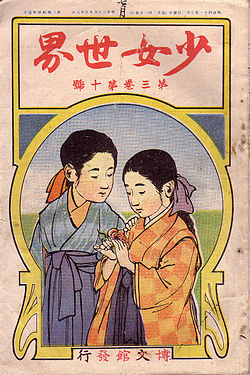Shōjo Sekai
 Volume 3 Number 10, published July 1, 1908. | |
| Editor / Publisher | Sazanami Iwaya |
|---|---|
| Categories | Shōjo, fiction, nonfiction, poetry, illustration, photography |
| Circulation | 200,000 (peak in 1910) |
| Publisher | Sazanami Iwaya |
| Founded | 1906 |
| Final issue | December 1931 |
| Company | Hakubunkan |
| Country | Japan |
| Based in | Tokyo |
| Language | Japanese |
Shōjo Sekai (
History[edit]
The Shōjo Sekai magazine was initially edited by renowned children's author Sueo Iwaya (
The magazine's early fiction output tended to be of a didactic nature, with tales about self-sacrifice and the importance of obeying one's parents. The stories then started to focus on passionate bonds between girls, often featuring tones typical of the Class S genre.[4]
According to Kiyoko Nagai, for the first ten years of its publication it was the best-selling shōjo magazine of the time, with peak circulations somewhere between 150,000 and 200,000 copies per issue.[5]
The final issue of Shōjo Sekai was the December 1931 issue.[1]
Contributors[edit]
Shōjo Sekai had a number of well known contributors over the years, including the following:
- Sazanami Iwaya (ja:
巌谷 小波 ), author, children's author, editor, publisher - Yasunari Kawabata, novelist and short story author
- Chiyo Kitagawa (
北川 千代 ), children's author - Tama Morita, essayist
- Midori Osaki (ja:
尾崎 翠 ), novelist - Kikuko Oshima (
尾島 菊子 ), author - Akiko Yosano, poet, feminist, pacifist, and social reformer
- Nobuko Yoshiya, author
References[edit]
- ^ a b Kikuyō-chō toshokan (
菊陽 町 図書館 , Kikuyō Town Library) Archived 23 August 2004 at the Wayback Machine. Meiji - Shōwa Shōjo Zasshi no Goshōkai (明治 〜昭和 少女 雑誌 のご紹介 , ″Meiji to Shōwa: An Introduction to Girls′ Magazines″) Archived 24 October 2008 at the Wayback Machine. Retrieved 16 September 2008. - ^ Sankō Toshokan (
三 康 図書館 , Sankō Library). Sankō Toshokan Zōsho Kensaku - Zasshi (三 康 図書館 蔵書 検索 ー雑誌 , Sankō Library Collection Search - Magazines) Archived 16 February 2012 at the Wayback Machine. Retrieved 16 September 2008. - ^ Nakagawa, Hiromi
中川 裕美 (2002). Waga Kuni ni Okeru “Shōjo Zasshi” no Tanjō to Hensen (我 が国 における『少女 雑誌 』の誕生 と変遷 , “The Birth and Transformations of ‘Girls’ Magazines’ in Our Nation”) Archived 24 October 2008 at the Wayback Machine. Chūkyō Joshi Daigaku Kodomo Bunkagaku Kenkyū Dai-kyū-gō (中京女子大学 子 ども文化 学 研究 第 9号 , Chukyo Women's University Children's Culture Studies, No. 9). Nagoya: Chūkyō Joshi Daigaku (中京女子大学 , Chukyo Women's University) Archived 17 September 2008 at the Wayback Machine. Retrieved 16 September 2008. - ^ Dollase, Hiromi Tsuchiya (2019). Age of Shōjo : the emergence, evolution, and power of Japanese girls' magazine fiction. Albany. ISBN 978-1-4384-7392-5. OCLC 1099255594.
{{cite book}}: CS1 maint: location missing publisher (link) - ^ Nagai, Kiyoko (
永井 紀代子 ) (2000). Tanjō - Shōjo-tachi no Kaihōku: “Shōjo Sekai” to ‘Shōjo Dokushokai’ (誕生 ・少女 たちの解放 区 〜『少女 世界 』と「少女 読書 会 」, "Birth of the Girls’ Liberated Zone: Girls’ World and ‘Girls’ Reading Circles’"). In Onna to Otoko no Jikū Kyū (女 と男 の時空 9, “Women's and Men's Space-Time 9”), edited by Nobuko Kohno (河野 信子 ), pp. 278-311. Tokyo: Fujiwara Shoten藤原 書店 . ISBN 978-4-89434-212-5.
External links[edit]
 Media related to Shōjo Sekai at Wikimedia Commons
Media related to Shōjo Sekai at Wikimedia Commons
- 1906 establishments in Japan
- 1931 disestablishments in Japan
- Children's magazines published in Japan
- Defunct literary magazines published in Japan
- Magazines established in 1906
- Magazines disestablished in 1931
- Magazines published in Tokyo
- Japanese literature stubs
- Literary magazine stubs
- Children's magazine stubs
